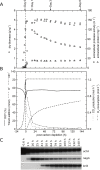The carbon starvation response of Aspergillus niger during submerged cultivation: insights from the transcriptome and secretome
- PMID: 22873931
- PMCID: PMC3527191
- DOI: 10.1186/1471-2164-13-380
The carbon starvation response of Aspergillus niger during submerged cultivation: insights from the transcriptome and secretome
Abstract
Background: Filamentous fungi are confronted with changes and limitations of their carbon source during growth in their natural habitats and during industrial applications. To survive life-threatening starvation conditions, carbon from endogenous resources becomes mobilized to fuel maintenance and self-propagation. Key to understand the underlying cellular processes is the system-wide analysis of fungal starvation responses in a temporal and spatial resolution. The knowledge deduced is important for the development of optimized industrial production processes.
Results: This study describes the physiological, morphological and genome-wide transcriptional changes caused by prolonged carbon starvation during submerged batch cultivation of the filamentous fungus Aspergillus niger. Bioreactor cultivation supported highly reproducible growth conditions and monitoring of physiological parameters. Changes in hyphal growth and morphology were analyzed at distinct cultivation phases using automated image analysis. The Affymetrix GeneChip platform was used to establish genome-wide transcriptional profiles for three selected time points during prolonged carbon starvation. Compared to the exponential growth transcriptome, about 50% (7,292) of all genes displayed differential gene expression during at least one of the starvation time points. Enrichment analysis of Gene Ontology, Pfam domain and KEGG pathway annotations uncovered autophagy and asexual reproduction as major global transcriptional trends. Induced transcription of genes encoding hydrolytic enzymes was accompanied by increased secretion of hydrolases including chitinases, glucanases, proteases and phospholipases as identified by mass spectrometry.
Conclusions: This study is the first system-wide analysis of the carbon starvation response in a filamentous fungus. Morphological, transcriptomic and secretomic analyses identified key events important for fungal survival and their chronology. The dataset obtained forms a comprehensive framework for further elucidation of the interrelation and interplay of the individual cellular events involved.
Figures






Similar articles
-
A Transcriptome Meta-Analysis Proposes Novel Biological Roles for the Antifungal Protein AnAFP in Aspergillus niger.PLoS One. 2016 Nov 11;11(11):e0165755. doi: 10.1371/journal.pone.0165755. eCollection 2016. PLoS One. 2016. PMID: 27835655 Free PMC article.
-
Submerged conidiation and product formation by Aspergillus niger at low specific growth rates are affected in aerial developmental mutants.Appl Environ Microbiol. 2011 Aug;77(15):5270-7. doi: 10.1128/AEM.00118-11. Epub 2011 Jun 7. Appl Environ Microbiol. 2011. PMID: 21652743 Free PMC article.
-
Systems approaches to predict the functions of glycoside hydrolases during the life cycle of Aspergillus niger using developmental mutants ∆brlA and ∆flbA.PLoS One. 2015 Jan 28;10(1):e0116269. doi: 10.1371/journal.pone.0116269. eCollection 2015. PLoS One. 2015. PMID: 25629352 Free PMC article.
-
Aspergillus niger genomics: past, present and into the future.Med Mycol. 2006 Sep;44 Suppl 1:S17-21. doi: 10.1080/13693780600921037. Med Mycol. 2006. PMID: 17050415 Review.
-
Colony differentiation of saprobic and pathogenic fungi in relation to carbon utilization.Fungal Genet Biol. 2025 Jun;179:104001. doi: 10.1016/j.fgb.2025.104001. Epub 2025 May 8. Fungal Genet Biol. 2025. PMID: 40348007 Review.
Cited by
-
Brown Rot-Type Fungal Decomposition of Sorghum Bagasse: Variable Success and Mechanistic Implications.Int J Microbiol. 2018 Apr 3;2018:4961726. doi: 10.1155/2018/4961726. eCollection 2018. Int J Microbiol. 2018. PMID: 29849648 Free PMC article.
-
A genomic survey of proteases in Aspergilli.BMC Genomics. 2014 Jun 25;15(1):523. doi: 10.1186/1471-2164-15-523. BMC Genomics. 2014. PMID: 24965873 Free PMC article.
-
Oxidative stress and carbon metabolism influence Aspergillus flavus transcriptome composition and secondary metabolite production.Sci Rep. 2016 Dec 12;6:38747. doi: 10.1038/srep38747. Sci Rep. 2016. PMID: 27941917 Free PMC article.
-
The DUG Pathway Governs Degradation of Intracellular Glutathione in Aspergillus nidulans.Appl Environ Microbiol. 2021 Apr 13;87(9):e01321-20. doi: 10.1128/AEM.01321-20. Print 2021 Apr 13. Appl Environ Microbiol. 2021. PMID: 33637571 Free PMC article.
-
Blocking utilization of major plant biomass polysaccharides leads Aspergillus niger towards utilization of minor components.Microb Biotechnol. 2021 Jul;14(4):1683-1698. doi: 10.1111/1751-7915.13835. Epub 2021 Jun 11. Microb Biotechnol. 2021. PMID: 34114741 Free PMC article.
References
-
- Pel HJ, de Winde JH, Archer DB, Dyer PS, Hofmann G, Schaap PJ, Turner G, de Vries RP, Albang R, Albermann K, Andersen MR, Bendtsen JD, Benen JA, van den Berg MA, Breestraat S, Caddick MX, Contreras R, Cornell M, Coutinho PM, Danchin EG, Debets AJ, Dekker P, van Dijck PW, van Dijk A, Dijkhuizen L, Driessen AJ, D’Enfert C, Geysens S, Goosen C, Groot GS, de Groot PW, Guillemette T, Henrissat B, Herweijer M, van den Hombergh JP, van der Heijden RT, van der Kaaij RM, Klis FM, Kools HJ, Kubicek CP, VanKuyk PA, Lauber J, Lu X, van der Maarel MJEC, Meulenberg R, Menke H, Mortimer MA, Nielsen J, Oliver SG, Olsthoorn M, Pal K, van Peij NN, Ram AFJ, Rinas U, Roubos JA, Sagt CM, Schmoll M, Sun J, Ussery D, Varga J, Vervecken W, van de Vondervoort PJ, Wedler H, Wosten HA, Zeng AP, van Ooyen AJ, Visser J, Stam H. Hondel. Genome sequencing and analysis of the versatile cell factory Aspergillus niger CBS 513.88. Nat Biotechnol. 2007;25(2):221–231. doi: 10.1038/nbt1282. - DOI - PubMed
-
- Andersen MR, Salazar MP, Schaap PJ, van der Vondervoort PJI, Culley D, Thykaer J, Frisvad JC, Nielsen KF, Albang R, Albermann K, Berka RM, Braus GH, Braus-stromeyer SA, Corrochano LM, Dai Z, Dijck PWMV, Hofmann G, Lasure LL, Magnuson JK, Menke H, Meijer M, Meijer SL, Nielsen JB, Nielsen ML, Ooyen AJJV, Pel HJ, Poulsen L, Samson RA, Stam H, Tsang A, Brink JMVD, Atkins A, Aerts A, Shapiro H, Pangilinan J, Salamov A, Lou Y, Lindquist E, Lucas S, Grimwood J, Grigoriev IV, Kubicek CP, Martinez D, Peij NMEV, Roubos JA, Nielsen J, Baker SE. Comparative genomics of citric-acid-producing Aspergillus niger ATCC 1015 versus enzyme-producing. Genome Res. 2011;21(6):885–897. doi: 10.1101/gr.112169.110. - DOI - PMC - PubMed
-
- Pitt JI, Hocking AD. Fungi and Food Spoilage. London: Blackie Academic and Professional; 1997.
Publication types
MeSH terms
Substances
Associated data
- Actions
- Actions
LinkOut - more resources
Full Text Sources
Molecular Biology Databases

